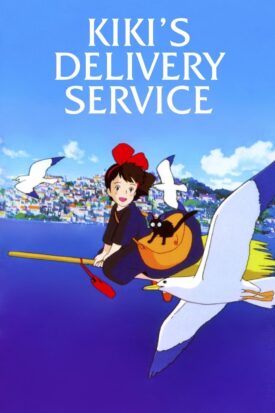Where Are You Going, My Little One, Little One
Kiki’s Delivery Service
By Eiko Kadono (Translated by Emily Balistrieri)

19 Jan, 2021
0 comments
Eiko Kadono 1985 Kiki’s Delivery Service is a coming-of-age fantasy novel, the first of a series featuring the eponymous Kiki. Illustrations are by Yuta Onoda. Translation is by Emily Balistrieri.
Kiki is half-witch: her mother Kokiri is a witch while her father, folklorist Okiro, is human. She has the choice of two heritages but can embrace only one. She chooses witch but … to her mother’s disappointment has mastered but a single witchy talent: flying her broom.
Nevertheless, Kiki is thirteen. For witches that means leaving home to find their destiny out in the world. Accompanied by her cat, Jiji, and her parents’ best wishes, Kiki flies away from her former home and heads off to her new one.
Kiki selects Koriko as her new home. Koriki is larger than the small town where she grew up but not so large as to intimidate the teen. It has no resident witch — no surprise since witches are rarer with each passing generation — which means she is free to settle there.
Kiki soon discovers that building her adult life is not as simple as picking a town. The townsfolk never thought the absence of a local witch was a problem. A witch in residence might be a problem. Who can say what behavior one can expect from such an unconventional person? It’s up to Kiki to win over the skeptical townsfolk.
Alas, this is where her focus on a single witch skill comes back to haunt her. Kokiri can fly and grow herbs for sneeze medicines. Kiki can fly. How can she make herself useful to the townsfolk with simple flight? It might have helped had Kiki studied harder!
Happenstance provides her with the insight she needs. She can deliver small packages quickly. Koriko soon discovers it had a pressing need for a plucky girl who can on short notice transport goods from one place to another, undeterred by lack of roads (in one case, actual land). Kiki’s business thrives.
Of course, that leaves all the other elements of a teen’s life — friends, boys, boyfriends — to provide interesting challenges.
~oOo~
Note for people who (like myself up to a few days ago) have only seen the movie adaptation of this:

while Miyazaki took fewer liberties with this than he did with, oh, Earthsea and Howl’s Moving Castle, the book and movie are somewhat different. Kiki looks older in the illustrated novel than she does in the film and animated Kiki doesn’t have book Kiki’s issue with teenage acne.
I cannot begin to express my deep concern about the declining state of witchcraft in modern Japan, a concern inspired by this work. There’s no sign Kiki will ever learn her mother’s herb skills. Even granting that her father is in a position to document Kokiri’s techniques, will this be enough to preserve them? Or they dwindle and disappear, as Nova Scotian Gaelic is vanishing? It may be that there are better ways to preserve witchcraft than homeschooling promising kids before sending them out into the world and hoping for the best [1]. How about a magic academy?
In fact, the theme of inevitable loss is far more prominent than I expected from a coming-of-age novel. Not only is magic slowly vanishing, but the novel takes time to point out that the arrangement between cat and witch is temporary. Eventually they will go their own ways, the cat with its mate and which Kiki with some guy. Nothing lasts.
Kiki does manage to have fun while carving out a new life for herself. The novel is rather episodic, without much of an arc aside from “growing up can be challenging” but it’s nonetheless entertaining.
Kiki’s Delivery Service is available here (Amazon US), here (Amazon Canada), here (Amazon UK), here (Barnes & Noble), here (Book Depository), and here (Chapters-Indigo).
1: This isn’t the sort of world where broom-riders are imbued with a certain level of immunity to physical harm. Kiki has a couple of close scrapes, which makes me wonder how many thirteen-year-old witches see their fourteenth birthday.
